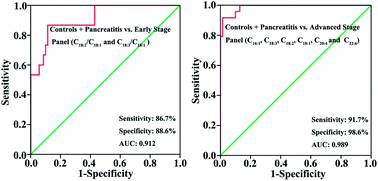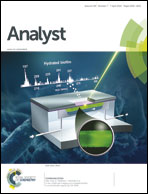High-throughput and high-sensitivity quantitative analysis of serum unsaturated fatty acids by chip-based nanoelectrospray ionization-Fourier transform ion cyclotron resonance mass spectrometry: Early stage diagnostic biomarkers of pancreatic cancer†
Abstract
In this study, Fourier transform ion cyclotron resonance mass spectrometry (FTICR MS) coupled with chip-based direct-infusion nanoelectrospray ionization source (CBDInanoESI) in a negative ion mode is first employed to evaluate the effect of serum and its corresponding supernatant matrixes on the recoveries of serum free fatty acids (FFAs) based on spike-and-recovery experimental strategy by adding analytes along with analog internal standard (IS). The recoveries between serum (69.8–115.6%) and the supernatant (73.6–99.0%) matrixes are almost identical. Multiple point internal standard calibration curves between the concentration ratios of individual fatty acids to ISs, (C17:1 as IS of C16:1, C18:3, C18:2, or C18:1 or C21:0 as IS of C20:4 or C22:6) versus their corresponding intensity ratios were constructed for C16:1, C18:3, C18:2, C18:1, C20:4 and C22:6, respectively, with correlation coefficients of greater than 0.99, lower limits of detection between 0.3 and 1.8 nM, and intra- and inter-day precision (relative standard deviations <18%), along with the linear dynamic range of three orders of magnitude. Sequentially, this advanced analytical platform was applied to perform simultaneous quantitative and qualitative analysis of multiple targets, e.g., serum supernatant unsaturated FFAs from 361 participants including 95 patients with pancreatic cancer (PC), 61 patients with pancreatitis and 205 healthy controls. Experimental results indicate that the levels of C18:1, C18:2, C18:3, C20:4 and C22:6, as well as the level ratios of C18:2/C18:1 and C18:3/C18:1 of the PC patients were significantly decreased compared with those of healthy controls and the patients with pancreatitis (p < 0.01). It is worth noting that the ratio of C18:2/C18:1, polyunsaturated fatty acids (PUFAs) (C18:2, C18:3, C20:4, and C22:6), panel a (C16:1, C18:3, C18:2, C20:4 and C22:6) and panel b (C18:2/C18:1 and C18:3/C18:1) performed excellent diagnostic ability, with an area under the receiver operating characteristic curve of ≥0.869, sensitivity of ≥85.7%, and specificity of ≥86.7% for differentiating the early stage PC from non-cancer subjects, which are greatly higher than those of clinically used serum biomarker CA 19-9. More importantly, this platform can also provide a fast and easy way to quantify the levels of FFAs in less than 30 s per sample.


 Please wait while we load your content...
Please wait while we load your content...